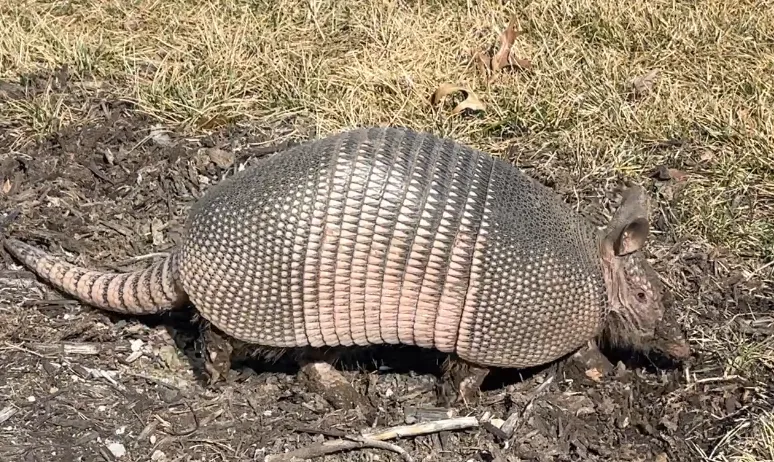
I saw my first three-dimensional nine-banded armadillo this week. We saw them 50 years ago, only as we neared Biloxi, on the coast (of a body of water whose name may change again in 46 months and 15 days.)
Alas, back then these pokey pedestrians became two-dimensional road pizza–occasionally with the tiny ears rising weakly into the vertical axis and waving in the swirl of the I-90 backwash.
But I have now been up close and personal with an individual Dasypus novemcintus. We saw two in a half hour here on the grounds of the Elder Reservation last week. Locals say they have not been present long at all in Central Missouri.
Northward and eastward migration continues steadily, from their Central and South America native home. Until 1850, none were found north of the Rio Grande. But the planet has become a more hospital place for these “turtle rabbits” (the Aztecs creatively named them and I like it!)
And so I thought I’d better get to know our new neighbors with more background and details. I will share a few things that jumped out at me.
ABOUT THEIR RANGE EXTENSION
At one time, they were a food item, even in the southwest US, but today, not so much. (I bet it tastes like chicken!) Also there are fewer top predators, save for highway traffic.

They survive heat and cold by burrowing, which makes them not a favorite of golf course managers and home owners and gardeners.
🥚 And it is interesting that they have high reproductive success due to a curious adaptation: An armadillo momma can delay implantation of a fertilized egg for several months until the season is right. Once implanted, it divides into four identical embryos giving rise to identical quintuplets of the same sex. And they share ONE placenta! I don’t think it is understood just how this biology came about.
AND SOME OTHER THINGS
- They can float while crossing rivers by inflating their stomachs and intestines and can swim underwater for six minutes. (Another bonus for expanding their range!)
- They may jump vertically when startled—a good thing to remember if you’re tempted to pick one up. You know you want to!
- They are vectors of leprosy, and pose some risk of disease in Texas, Louisiana and Florida, but the condition is not the Biblical fingers-falling-off kind. Antibiotics nip it in the bud. Even so, cuddling is not recommended.
- And they have skin that glows under ultraviolet light. (So to do scorpions and tomato horn worms.) Why the heck?
SO ARE THEY WELCOME AS NEWCOMERS?
Technically, an invasive organism has “the potential for economic or environmental harm or harm to human health.” So armadillos? The jury is out. But in the plus column:
Armadillo burrows end up providing habitat and critical refuge for lots of other animals–64 different species of birds, mammals, reptiles, and amphibians use armadillo burrows, according to a 2022 study conducted in Arkansas. And in decades of study and observation, very little research (possibly none) has identified clear, ecosystem-level harms resulting from the presence of armadillos in the U.S. ~ Popular Science
Maybe these turtle-rabbits are the simply “neonatives” that will come to find their place in the local habitats where they survive?
🥕 But the first time they root up my plants in the community garden here, we are going to have words.
